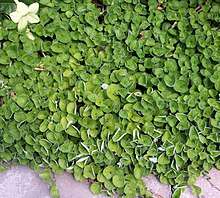Dichondra
| Dichondra | |
|---|---|
 | |
| Dichondra micrantha | |
| Scientific classification | |
| Kingdom: | Plantae |
| Clade: | Angiosperms |
| Clade: | Eudicots |
| Clade: | Asterids |
| Order: | Solanales |
| Family: | Convolvulaceae |
| Tribe: | Dichondreae |
| Genus: | Dichondra J.R.Forst. & G.Forst.[1] |
| Species | |
|
See text | |
| Synonyms | |
|
Dichondropsis Brandegee[1] | |
Dichondra is a small genus of flowering plants in the morning glory family, Convolvulaceae. They are prostrate, perennial, herbaceous plants, with creeping stems which take root readily at the leaf nodes. The flowers are white, greenish or yellowish, 2–3 mm diameter.
The number of species is disputed, with some authors dividing the genus regionally into about ten separate species, while others accept only two species. Members of the genus are commonly known as ponysfoots[2] and are native to tropical and warm temperate regions around the world.
The genus name is derived from the Greek words δίς (dis), meaning "two", and χόνδρος (chondros), meaning "grain". It refers to the fruits.[3]
Selected species
- Dichondra argentea Humb. & Bonpl. ex Willd. – silver dichondra — Mexico, Texas.[4]
- Dichondra brachypoda Wooton & Standl. – New Mexico ponysfoot
- Dichondra carolinensis Michx. – Carolina ponysfoot [5]
- Dichondra donelliana Tharp & M.C.Johnst. – California ponysfoot [6]
- Dichondra micrantha Urb. – Asian ponysfoot
- Dichondra microcalyx Meisn. – "Oreja de ratón — South America[7]
- Dichondra occidentalis House – western dichondra — Southern California coast.[8]
- Dichondra recurvata Tharp & M.C.Johnst. – oakwoods ponysfoot
- Dichondra repens J.R.Forst. & G.Forst. — kidney weed
- Dichondra sericea Sw. – silverleaf ponysfoot[2][9]
Cultivation and uses
Some Dichondra species are cultivated as ornamental plants, with cultivar selections also available. Dichondra micrantha is used as a groundcover. Dichondra argentea is a light silver leaved accent plant. The Dichondra argentea 'Silver Falls' cultivar is often used for trailing over the rims of potted plants, and has lower water needs.[10]
Dichondra micrantha was very popular in Southern California in the 1950s and 1960s as a grass substitute for lawns. Each leaf consists of a stem with a nearly circular or kidney-shaped horizontal leaf top, between 8–25 mm in diameter with a 20–35 mm petiole. A healthy lawn consisting entirely of Dichondra is fairly difficult to start, grow, and maintain. Neighbors' Bermuda grass often seeded in, with Oxalis sp. and other weeds.
In some habitats and landscapes of the United States, some of the non-native Dichondra species are treated as weeds.
References
- 1 2 "Genus: Dichondra J. R. Forst. & G. Forst". Germplasm Resources Information Network. United States Department of Agriculture. 2003-12-11. Retrieved 2012-04-30.
- 1 2 "Dichondra". Integrated Taxonomic Information System. Retrieved 2012-04-30.
- ↑ Everett, Thomas H. (1981). The New York Botanical Garden Illustrated Encyclopedia of Horticulture. 4. Courier Corporation. p. 1059. ISBN 978-0-8240-7234-6.
- ↑ San Marcos Growers treatment: Dichondra argentea (silver dichondra)
- ↑ Encyclopedia of Life: Information on Dichondra carolinensis (Carolina Ponysfoot, Grass Ponysfoot)
- ↑ Jepson: Dichondra donelliana
- ↑ Dichondra microcalyx (in Spanish)
- ↑ Jepson: Dichondra occidentalis
- ↑ "GRIN Species Records of Dichondra". Germplasm Resources Information Network. United States Department of Agriculture. Retrieved 2012-04-30.
- ↑ Missouri Botanical Garden horticultural treatment: Dichondra argentea 'Silver Falls'
- Everitt, J.H.; Lonard, R.L.; Little, C.R. (2007). Weeds in South Texas and Northern Mexico. Lubbock: Texas Tech University Press.
- "Dichondra J.R.Forst. & G.Forst". Australian Plant Name Index (APNI), IBIS database. Centre for Plant Biodiversity Research, Australian Government.
External links
| Wikimedia Commons has media related to Dichondra. |
| Wikispecies has information related to Dichondra |